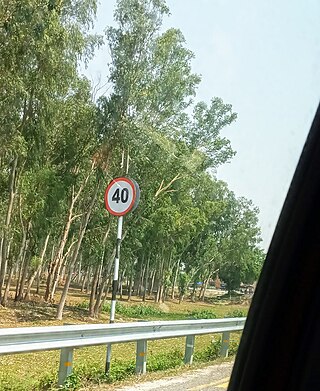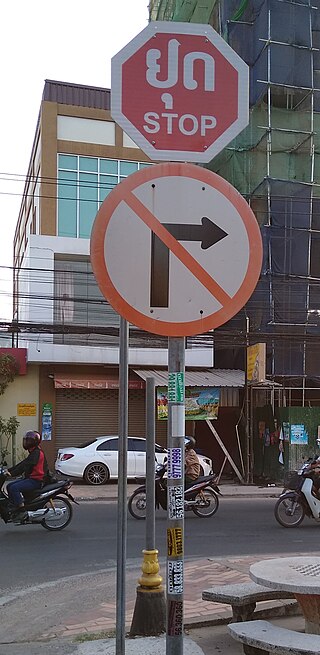
A salute is usually a formal hand gesture or other action used to display respect in military situations. Salutes are primarily associated with the military and law enforcement, but many civilian organizations, such as Girl Guides, Boy Scouts and the Salvation Army use formal salutes. Ordinary civilians also salute informally to greet or acknowledge the presence of another person, such as a tip of the hat or a hand wave to a friend or neighbor.

Traffic comprises pedestrians, vehicles, ridden or herded animals, trains, and other conveyances that use public ways (roads/sidewalks) for travel and transportation.

Traffic lights, traffic signals, or stoplights – also known as robots in South Africa and Namibia – are signalling devices positioned at road intersections, pedestrian crossings, and other locations in order to control the flow of traffic.

Bicycle law in California is the parts of the California Vehicle Code that set out the law for persons cycling in California, and a subset of bicycle law in the United States. In general, pretty much all the same rights and responsibilities that apply to car drivers apply to bicycle riders as well.

Overtaking or passing is the act of one vehicle going past another slower moving vehicle, travelling in the same direction, on a road. The lane used for overtaking another vehicle is often a passing lane farther from the road shoulder, which is to the left in places that drive on the right and to the right in places that drive on the left.

Trikonasana or Utthita Trikonasana, [Extended] Triangle Pose is a standing asana in modern yoga as exercise. Variations include Baddha Trikonasana and Parivrtta Trikonasana.

In traffic engineering, there are regional and national variations in traffic light operation. This may be in the standard traffic light sequence or by the use of special signals.

Road signs in Italy conform to the general pattern of those used in most other European countries, with the notable exception that the background of motorway (autostrada) signs is green and those for 'normal' roads is blue. They are regulated by the Codice della Strada and by the Regolamento di Attuazione del Codice della Strada in conformity with the 1968 Vienna Convention on Road Signs and Signals.

The geometric design of roads is the branch of highway engineering concerned with the positioning of the physical elements of the roadway according to standards and constraints. The basic objectives in geometric design are to optimize efficiency and safety while minimizing cost and environmental damage. Geometric design also affects an emerging fifth objective called "livability," which is defined as designing roads to foster broader community goals, including providing access to employment, schools, businesses and residences, accommodate a range of travel modes such as walking, bicycling, transit, and automobiles, and minimizing fuel use, emissions and environmental damage.

The design of road signs in Poland is regulated by Regulation of the Ministers of Infrastructure and Interior Affairs and Administration on road signs and signals. The Annex 1 to the regulation describes conditions related to usage of the road signs – size, visibility, colors and light reflections, typeface and text, criteria of choosing the type of foil to signs faces, colorful specimens and schematics.
Cycling in Illinois encompasses recreation, bikeways, laws and rules, and advocacy. The director of the Illinois Department of Natural Resources, Joel Brunsvold, explained Illinois cycling opportunities: “Bicycle riding is one of the most popular outdoor recreational activities in Illinois, enjoyed by young and old alike...Illinois has a variety of trails for the public to enjoy. The terrain includes flat prairie land to rolling hills, towering bluffs to the breathtaking river and lakefront views.” Many communities across the state are updating bicycle infrastructure in order to accommodate the increased number of cyclists on the roads.

Road signs in Greece are regulated by the Ministry of Transport and the Hellenic Traffic Police, according to the Greek Highway Code.

Road signs in Pakistan are modelled on the British road sign system, with an exceptional difference being that they are bilingual and contain messages in Urdu, the national language, and English, and in some cases, the local regional or provincial languages. Pakistan drives on the left side of the road and follows the left-hand traffic system. Vehicles must be overtaken on their right.

Following international norms, road signs in Nepal are controlled by the Nepali Department of Roads and are heavily influenced by those used in the United Kingdom.

Road signs in Mauritius are standardised traffic signs used in Mauritius according to the Traffic Signs Regulations 1990. They are heavily modelled on road signs in the United Kingdom, since Mauritius is a former British colony and drives on the left.

Road signs in Hong Kong are standardised by the Transport Department. Due to being a former British territory, the road signage in Hong Kong is similar to road signs in the United Kingdom, with the addition of Traditional Chinese characters.

Road signs in Laos generally follow those used in most European countries as set out in the Vienna Convention on Road Signs and Signals. Despite this, the country itself has never signed the Vienna Convention on Road Signs and Signal. Inscriptions on traffic signs are in Lao, the national language of Laos. However, English is also used for stop and important public places such as tourist attractions, airports, railway stations, and immigration checkpoints. Both Lao and English are used on directional signage.

Road signs in France refer to all conventional signals installed on French roads and intended to ensure the safety of road users, either by informing them of the dangers and regulations relating to traffic as well as elements useful for decision-making, or by indicating to them the landmarks and equipment useful for their travel on the national territory. They generally largely follow the general European conventions concerning the use of shape and color to indicate their function. France is a signatory to the 1968 Vienna Convention on Road Signs and Signals. France signed the Vienna Convention on Road Signs and Signals on 8 November 1968 and ratified it on 9 December 1971.

Road signs in Armenia are similar to the signs of other post-Soviet states and most European road sign systems. Armenia is a signatory of the Vienna Convention on Road Traffic and the Vienna Convention on Road Signs and Signals. The Ministry of Transport regulates these icons, while the police enforces them. Road signs ensure transport vehicles move safely and orderly, as well as, to inform both pedestrians and motorists of traffic rules.
Road signs in Saudi Arabia differ by locale, but they do tend to closely follow European practices with certain distinctions and conform to the general pattern as set out in the Vienna Convention of Road Signs and Signals. Road signs display text in Arabic language and English language. Distances are displayed in metric units and in Eastern Arabic numerals.




















